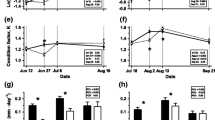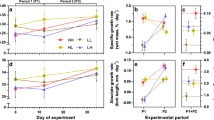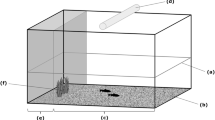Abstract
The effect of contest and scramble competition on the growth performance of wild and sea-ranched juvenile (0+) brown trout, Salmo trutta, originating from the River Dalälven, Sweden was scrutinised. In a mirror image stimulation (MIS) experiment, and in a 35 000 1 stream-water aquarium the trout was studied for three weeks (20 individuals in each of four replicates). Activity in MIS was correlated with swimming activity in the stream-water aquarium. The MIS results could not be used for predicting any social behaviour patterns or the growth performance of a fish. No behavioural differences between the two strains were noted. However, the sea-ranched strain grew faster than the wild one, both in regard to the RNA/DNA ratio and the weight-specific growth rate. Because the strains had the same genetic background and prior to the experiments were raised under similar hatchery condition, the results of this study suggest that the sea-ranching process selects for faster juvenile growth in brown trout. The ultimate mechanisms underlying the faster growth by the domesticated strain probably involves both contest and scramble competition.
Similar content being viewed by others
References cited
Baenninger, R. 1968. Catechol amines and social relations in Siamese fighting fish. Anim. Behav. 16: 442-447.
Boyd, R. & J.B. Silk. 1983. A method for assigning cardinal dominance ranks. Anim. Behav. 31: 45-58.
Doyle. R.W. & A.J. Talbot. 1986. Artificial selection on growth and correlated selection on competitive behaviour in fish. Can. J. Fish. Aquat. Sci. 43: 1059-1064.
Fenderson, O.C., W.H. Everehart & K.M. Muth. 1968. Comparative agonistic behavior of hatchery-reared and wild salmon in aquaria. J. Fish. Res. Board Can. 25: 1-14.
Fleming, I.A. & M.R. Gross. 1992. Reproductive behavior of hatchery and wild coho salmon (Oncorhynchus kisutch): does it differ? Aquaculture 103: 101-1212.
Fleming, I.A., B. Jonsson & M.R. Gross. 1994. Phenotypic divergence of sea-ranched farmed, and wild salmon. Can. J. Fish. Aquat. Sci. 51: 2808-2824.
Francis, R.C. 1983. Experimental effects on agonistic behaviour in the paradise fish, Macropodus opercularis. Behaviour 85: 292-313.
Francis, R.C. 1984. The effects of bidirectional selection for social dominance on agonostic behaviour and sex ratios in the paradise fish (Macropodus opercularis). Behaviour 90: 25-45.
Franck D., R.-P. Hannes, H. Lanffermann & A. Ribowski. 1985. Effects of social isolation on aggressiveness in fish with special reference to the swordtail (Xiphophorus helleri). Behav. Processes 10: 415-427.
Franck, D. & A. Ribowski. 1987. Influence of prior agonistic experiences on aggression measures in the male swordtail (Xiphophorus helleri). Behaviour 103: 217-240.
Gilliam, J.F. & D.F. Fraser. 1987. Habitat selection under predation hazard: test of a model with foraging minnows. Ecology 68: 1856-1862.
Gotceitas, V. & J.-G. Godin. 1991. Foraging under the risk of predation in juvenile Atlantic salmon (Salmo salarL.): effects of social status and hunger. Behav. Ecol. Sociobiol. 29: 255-261.
Hindar, K., N. Ryman & F. Utter. 1991. Genetic effects of cultured fish on natural fish populations. Can. J. Fish. Aquat Sci. 48: 945-957
Jakobsson, S., T. Radesäter & T. Järvi. 1979. On the fighting behaviour of Nannacara anomala(Pisces, Cichlidae) males. Z. Tierpsychol. 49: 210-220.
Jakobsson, S., 0. Brick & C. Kullberg. 1995. Escalated fighting behaviour incurs increased predation risk. Anim. Behav. 49: 483-499.
Johnsson J.I. & M.V. Abrahams. 1991. Interbreeding with domestic strain increases foraging under threat of predation in juvenile steelhead trout (Oncorhynchus mykiss): an experimental study. Can. J. Fish. Aquat. Sci. 48: 243-247.
Johnsson, J.I., W.C. Clark & R.E. Withler. 1993. Hybridization with domesticated rainbow trout (Oncorhynchus mykiss) reduces seasonal variation in growth of steelhead trout (O. mykiss). Can. J. Fish. Aquat. Sci. 50: 480-487.
Johnsson, J.I., E. Petersson, E. Jönsson, B. Th. Björnsson & T. Järvi. 1996. Domestication and growth hormone alter antipredator behaviour and growth patterns in juvenile brown trout, Salmo trutta. Can. J. Fish. Aquat. Sci. 53: 1546-1554.
Johnsson N., B. Johnsson & I.A. Fleming. 1996. Does early growth cause a phenotypically plastic response in egg production of Atlantic salmon? Func. Ecol. 10: 89-96.
Lima S.L. & I.A. Dill. 1990. Behavioural decisions made under the risk of predation: a review and prospectus. Can. J. Zool. 68: 619-640.
Lomnicki A. 1988. Population ecology of individuals. Monographs in Population Biology 25, Princeton University Press, Princeton. 223 pp.
Martel, G. & L. Dill. 1993. Feeding and aggressive behaviours in juvenile coho salmon (Oncorhynchus kisutch) under chemically-mediated risk of predation. Behav. Ecol. Sociobiol. 32: 365-370.
Meliska, C.J., J.A. Meliska & H.V.S. Peeke. 1980. The relationship of mirror-elicted display to combat behaviors in Betta splendens. Behav. Neural. Biol. 30: 207-217.
Mesa, M.G. 1991. Variation in feeding, aggression, and position choice between hatchery and wild cutthroat trout in an artificial stream. Trans. Amer. Fish. Soc. 120: 723-727.
Metcalfe, N.B. 1986. Intraspecific variation in competitive ability and food intake in salmonids: consequences for energy budgets and growth rates. J. Fish Biol. 28: 525-531.
Moyle, P.B. 1969. Comparative behavior of young brook trout of domestic and wild origin. Progr. Fish-Cult. 31: 51-56.
Petersson, E. & T. Järvi. 1993. Differences in reproductive traits between sea-ranched and wild sea-trout (Salmo trutta) originating from a common stock. Nordic J. Freshw. Res. 68: 91-97.
Petersson, E. & T. Järvi. 1995. Evolution of morphological traits in sea trout (Salmo trutta) parr (0+) through sea-ranching. Nordic J. Freshw. Res. 70: 62-67.
Petersson, E., T. Järvi., N.G. Steffner. & B. Ragnarsson. 1996. The effect of domestication on some life history traits of sea trout (Salmo trutta) and Atlantic salmon (S. salar) J. Fish Biol. 48: 776-791.
Rosenau, M.L. & J.D. McPhail. 1987. Inherited differences in agonistic behavior between two populations of coho salmon. Trans. Amer. Fish. Soc. 116: 646-654.
Ruzzante, D.E. 1994. Domestication effects on aggressive and schooling behavior in fish. Aquaculture 120: 1-24.
SAS Institute Inc. 1987. SAS/STAT Guide for personal computers, version 6 ed. SAS Institute, Cary.
Swain, D.P. & L.B. Holtby. 1989. Differences in morphology and behavior between juvenile coho salmon (Oncorhynchus kisutch) reared in a lake or in its tributary stream. Can. J. Fish. Aquat. Sci. 46: 1406-1414.
Swain, D.P. & B.E. Riddell. 1990. Variation in agonistic behavior between newly emerged juveniles from hatchery and wild populations of coho salmon, Oncorhynchus kisutch. Can. J. Fish. Aquat. Sci. 47: 566-571.
Swain, D.P., B.E. Riddell. & C.B. Murray. 1991. Morphological differences between hatchery and wild populations of coho salmon (Oncorhynchus kisutch): environmental versus genetic origin. Can. J. Fish. Aquat. Sci. 48: 1783-1791.
Symons, P.E.K. 1968. Increase in aggression and in strength of the social hierarchy among juvenile Atlantic salmon deprived of food. J. Fish. Res. Board Can. 25: 2387-2401.
Taylor, E.B. 1988. Adaptive variation in rheotactic and agonistic behavior in newly emerged fry of chinook salmon, Oncorhynchus tshawytsha, from ocean-and stream-type populations. Can. J. Fish. Aquat. Sci. 45: 237-243.
Taylor, E.B. & P.A. Larkin. 1986. Current response and agonistic behavior in newly emerged fry of chinook salmon, Oncorhynchus tshawytsha, from ocean-and stream-type populations. Can. J. Fish. Aquat Sci. 43: 565-573.
Vincent, R.E. 1960. Some influences of domestication upon three stocks of brook trout (Salvelinus fontinalis, Mitchill). Trans. Amer. Fish. Soc. 89: 35-52.
Author information
Authors and Affiliations
Rights and permissions
About this article
Cite this article
Petersson, E., Järvi, T. Both Contest and Scramble Competition Affect the Growth Performance of Brown Trout, Salmo Trutta, Parr of Wild and of Sea-ranched Origins. Environmental Biology of Fishes 59, 211–218 (2000). https://doi.org/10.1023/A:1007645411586
Issue Date:
DOI: https://doi.org/10.1023/A:1007645411586




